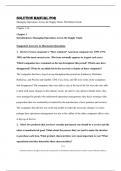Exam (elaborations)
Solution Manual for Managing Operations Across the Supply Chain, 5th Edition Swink Chapter 1-16. A+
Solution Manual for Managing Operations Across the Supply Chain, 5th Edition Swink Chapter 1-16. A+
Chapter 1
Introduction to Managing Operations Across the Supply Chain
Suggested Answers to Discussion Questions
1. Review Fortune magazine’s ―Most Admired‖ American companies for 1959, 1979...
[Show more]
Preview 4 out of 402 pages
Uploaded on
March 10, 2024
Number of pages
402
Written in
2023/2024
Type
Exam (elaborations)
Contains
Questions & answers
Course
Managing Operations Across the Supply Chain, 5th
All documents for this subject (1)
Solution Manual for




